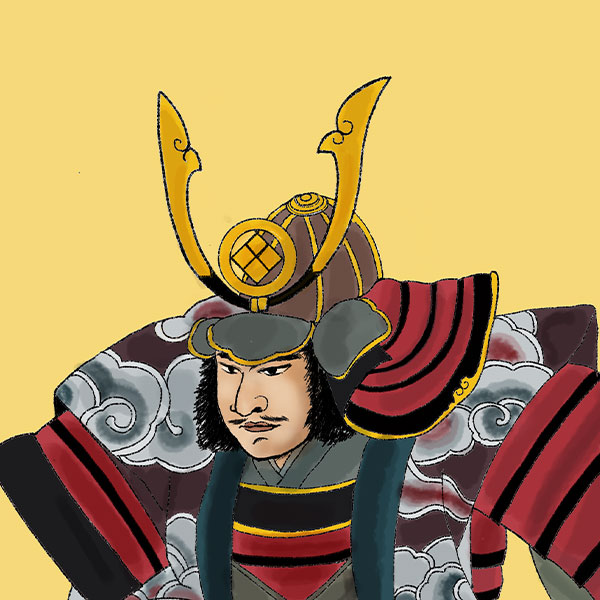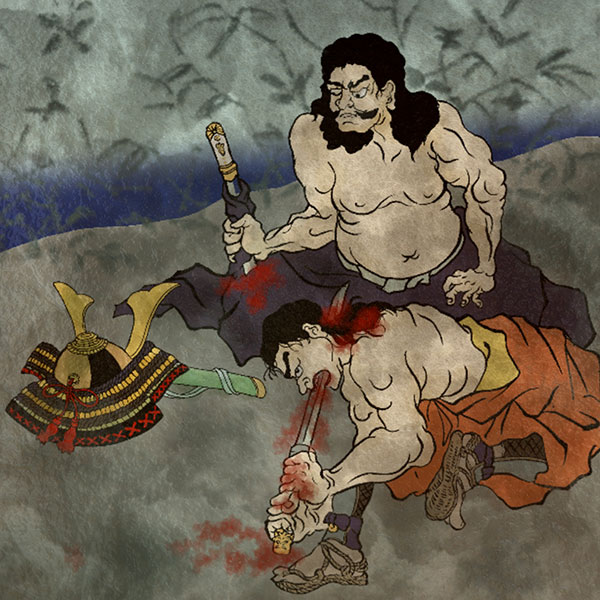Morinobu Nishina (1/2)Prince of the Takeda Clan who died for his brother

Morinobu Nishina
- Article category
- biography
- name
- Morinobu Nishina (1557-1582)
- place of birth
- Yamanashi Prefecture
- Related castles, temples and shrines
- related incident
Nishina Morinobu was born during the Sengoku period as the fifth son of Takeda Shingen, a feudal lord in Kai Province. As he grew up, he was adopted into the powerful Nishina family of Shinshu, and ruled the northern part of Shinano Province. The Takeda clan flourished during the time of Takeda Shingen, but when Takeda Katsuyori, Morinobu's older brother, took over, the clan's power declined and some people gave up on it. However, Nishina Nobumori helped his brother Katsuyori and met a heroic end. In this article, we will look at Nishina Nobumori.
The Birth of Morinobu Nishina
Nishina Morinobu was born in 1557 to Takeda Shingen, a feudal lord in Kai Province, and his wife Yukawa (a concubine of Shingen and the daughter of Yukawa Nobumori). His childhood name was Goro. He was Shingen's fifth son, and his half-brothers were Takeda Yoshinobu and Katsuyori, and his younger siblings were Katsuyama Nobutada, Matsuhime (fiancee of Oda Nobutada), and Kikuhime (wife of Uesugi Kagekatsu).
His father, Takeda Shingen, ruled Kai Province, but invaded the neighboring province of Shinano. Once he took control of Shinano, he fought with Uesugi Kenshin of Echigo Province (present-day Niigata Prefecture), which bordered the area. Nishina Morimasa, lord of Mori Castle in Azumi County, Shinano, also fought against the Uesugi as a subordinate of the Takeda clan. Nishina Morimasa also participated in the Battle of Kawanakajima (the 4th Battle), a major battle between the Takeda and Uesugi clans, but during this time his retainers at Mori Castle betrayed him to the Uesugi clan. This rebellion was put down, but Nishina Morimasa was taken to Kai Province and it is said that he was either forced to commit suicide or imprisoned.
Thus, the Nishina family was left without a head. At the same time, Takeda Shingen was appeasing the kokujinshu (small local clans) that made up Shinano Province. He appointed his own son as head of the Unno family, and sent a vassal to the Kosaka family as head. Then, in 1561 (Eiroku 4), he married the daughter of Nishina Morimasa, who had been arrested, and installed his own son, Nishina Morinobu, as head of the family (Nishina Morimasa had an eldest and second son, but with Takeda Shingen's permission, the brothers became priests at Iizuna Shrine, and served as priests throughout the Edo period). Nishina Morinobu, who inherited the Nishina family, became the commander of 100 Takeda family members.
Succeeded the Nishina family
The Nishina family, inherited by Nishina Morinobu, developed Nishina Sho during the Heian period and was born as a powerful clan that ruled the Azumi district of Shinano Province (present-day northern Nagano Prefecture). As a powerful clan in Shinano Province, the Nishina name can be seen participating in the uprising of Kiso Yoshinaka and the Jōkyū War.
In the late Muromachi period, entering the Warring States period, the Nishina clan cooperated with the Ogasawara clan, who became the guardian of Shinano, and the Murakami clan, who was a powerful local lord, to oppose Takeda Shingen of Kai Province, who had invaded Shinano Province. However, in 1548 (Tenbun 17), the Nishina clan left the Ogasawara clan, and in 1550 (Tenbun 19), became vassals of the Takeda clan. The Nishina clan, who became vassals of the Takeda clan, welcomed Takeda Shingen's son, Morinobu, as their head. When Morinobu succeeded as head of the Nishina clan, he secured the Nishina family's fief in Azumi County, Shinano Province, and other matters. He also worked hard to guard the enemy Uesugi clan's territory in Echigo Province, to improve transportation routes, and to control the local lords under the Nishina family's territory. He also worked hard on domestic affairs, such as establishing Henjokoin as a lodging house for the Nishina family and the local lords of Azumi County when they made a pilgrimage to Koyasan in 1577 (Tensho 5).
Thus, Morinobu spent over 10 years pacifying northern Shinshu while remaining vigilant against the neighboring Uesugi clan. However, while Nishina Morinobu was in control of the Nishina clan's territory, his father, Takeda Shingen, died.
The Death of His Father and Takeda Katsuyori
When Nishina Morinobu inherited the Nishina family, there were major developments in the Kinai region.
In 1568, Oda Nobunaga supported Ashikaga Yoshiaki and went to Kyoto. Ashikaga Yoshiaki became the 15th Shogun of the Muromachi Shogunate. The Oda and Takeda clans initially had friendly relations. However, when the relationship between Shogun Ashikaga Yoshiaki and Oda Nobunaga, who had supported him, fell apart, Ashikaga Yoshiaki requested that daimyo from various provinces support him. Takeda Shingen also received a request from Ashikaga Yoshiaki.
As a result of this, the relationship between Oda Nobunaga and Takeda Shingen became strained from around 1571.
In 1572, Takeda Shingen left Kai Province after receiving an order from Ashikaga Yoshiaki to subjugate Oda Nobunaga. On the way, he drove out Tokugawa Ieyasu, who ruled Mikawa Province (Battle of Mikatagahara). However, Takeda Shingen died on the way west. The Takeda clan, which was on its way to Kyoto, turned back. With no head of the family, Takeda Katsuyori, the half-brother of Nishina Morinobu, became the head of the family.
Nishina Morinobu, who served his brother Takeda Katsuyori, continued to defend the northern part of Shinano Province. When Takeda Katsuyori and Uesugi Kagekatsu, the lord of Echigo Province, formed an alliance (the Shinetsu Alliance), Nishina also occupied Nechi Castle in Nishihama (Itoigawa City, Niigata Prefecture) based on the alliance.
Thus, while his brother Takeda Katsuyori succeeded Shingen and Nishina Morinobu was strengthening the defenses of Shinshu, the Oda and Takeda clans had become inseparable.
Battle of Takato Castle
Takeda Katsuyori became the head of the Takeda clan. He was fighting with Tokugawa Ieyasu in Mikawa and Totomi (present-day eastern Aichi Prefecture to western Shizuoka Prefecture). As the Oda clan was on the side of the Tokugawa clan, the Takeda clan was inevitably in a state of tension with both the Tokugawa and Oda clans.
Then, in 1575, Takeda Katsuyori invaded Mikawa Province. The Tokugawa clan resisted with the help of Oda Nobunaga, and the Battle of Nagashino took place. The Takeda clan suffered a major defeat in this battle. The Takeda clan lost many of their retainers in this battle, and went from invading neighboring provinces to being on the defensive, focusing their efforts on the defense of Shinano and Kai provinces.
In 1581, Takeda Katsuyori reorganized his military, and Nishina Morinobu assumed the role of lord of Takato Castle in addition to Mori Castle in Shinano Province, his main territory. However, Takeda Katsuyori's relatives and vassals, dissatisfied with his politics, betrayed him one by one. Kiso Yoshimasa, the son-in-law of Takeda Shingen, defected to the Oda clan. With Kiso Yoshimasa's betrayal, the border between Mino Province, the main territory of the Oda clan, and Shinano Province became weak.
In February 1582, Oda Nobunaga launched a conquest of Kai Province by the Oda clan, the Tokugawa clan, and the Hojo clan of Kanto. Nishina Morinobu, along with the brothers Odayama Masanari and Daigakusuke, and 3,000 soldiers, barricaded himself in Takato Castle. Takato Castle was surrounded by a large army of 50,000 led by Oda Nobutada, the eldest son of Oda Nobunaga.
Just before the siege, Oda Nobutada urged Nishina Morinobu to surrender, but Morinobu refused. It is said that he cut off the ears of a monk who came as an emissary and drove him away.
In the early morning of March 2nd, the Oda clan attacked Takato Castle. After a brave fight, Nishina Morinobu committed suicide at the age of 26. He was killed along with about 500 of his retainers, and Takato Castle fell.
While the Takeda clan gradually abandoned Takeda Katsuyori, Nishina Morinobu did not betray his brother until the very end and met a heroic end. After committing seppuku, his head was delivered to Oda Nobutada. He was then executed by Hasegawa Munehito at the crossroads of Ichijo-dori in Kyoto, alongside Takeda Katsuyori, Nobukatsu, and Nobutoyo. His body was given a lavish funeral by the people who adored Nishina Morinobu.
Nishina Morinobu's children survived, and many of them served as hatamoto (samurai vassals) of the Edo Shogunate, with some of the family continuing into the Meiji period and beyond.
Takato Castle
Takato Castle was a castle located in Takato, Ina County, Shinano Province (Takato Town, Ina City, Nagano Prefecture) and was also known as Kabutoyama Castle.
The Suwa clan was a local clan in Shinano Province, and Takato Yoritsugu, a member of the Suwa clan, used Takato Castle as his residence. In 1541, Takato Yoritsugu was secretly transferred from the Suwa clan to Takeda Shingen, and the Takeda clan used Takato Castle as their base in the Shinano Ina region and carried out extensive renovations. After that, Takeda Katsuyori and Nishina Morinobu became lords of the castle, but it fell into the hands of Oda Nobunaga.
- related incident

- WriterTomoyo Hazuki(Writer)I have loved history and geography since my student days, and have enjoyed visiting historical sites, temples and shrines, and researching ancient documents. He is especially strong in medieval Japanese history and European history in world history, and has read a wide range of things, including primary sources and historical entertainment novels. There are so many favorite military commanders and castles that I can't name them, but I especially like Hisashi Matsunaga and Mitsuhide Akechi, and when it comes to castles, I like Hikone Castle and Fushimi Castle. Once you start talking about the lives of warlords and the history of castles, there's a side of you that can't stop talking about them.



